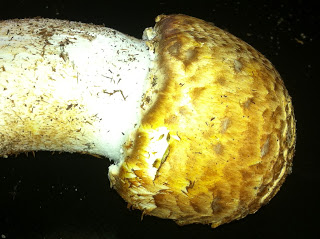Agaricus augustus
Posted by Quinn 5/4/12 ---- Scroll Down to See the Discussion


Quinn: Well, I am trying this group out for the first time so I will see how it goes.
I imagine you all need more info but this is what I am confident about at the moment.
I found this mushroom outside a store at the Portland Meadows.
It was in a pile of woodchips with fairly sandy soil.
There was an older specimen I saw a few weeks ago.
It had dark brown spores.
The mushroom I picked almost immediately bruised yellow
on the cap and the stalk, but faded on the stalk. It has a fairly sweet almondy smell.
The stipe is fairly smooth, sort of fibrillose/scaly.
I am going back and forth about the id because of the difficulty in identifying agaricus.
Are there any agaricus that are common in this area in the Spring?
I am thinking this is agaricus perobscurus.
Does that occur here?
Sava: Most likely, this is Agaricus augustus---
The Prince.
Congratulations! All characters that you mentioned match.
And the pictures look right for (young) augustus.
Read a description in your book and see if everything looks right.
Then you may consider eating them.
(The maggots have already finished the ID part and will get them soon.)
One of my top three edibles.
Dick B: I wouldn't admit to having much skill with Agaricus but the fibrils on the cap
look a lot like A. Augustus and the almondy odor does fit.
However, the cap shape certainly doesn't look right.
A. Augustus does stain but usually not as brightly as your specimen.
I think Judy Roger has had more experience with Agaricus than anyone around here.
I'd like to hear what she thinks.
Sava: The cap shape looks OK to me.
We have a patch at Nike campus where the Prince grows every year,
sometimes several times from Spring to September,
and the young caps are typically like this.
If you google "agaricus augustus", and click on "images of agaricus augustus",
there will be many pictures of the young ones.
Please correct me if I'm not seeing some easily explained mismatch.
Dick B: It sounds like you have probably seen many more young caps than I have Sava.
I was just thinking they should have a little of that squared off shape by the time Quinn collected it.
Judy: This really does fit quite well for Agaricus augustus,
including the rounded ball-like cap. the brownish scales, yellow staining,
odor, plus habitat fit quite well.
Am just surprised it has appeared already, since it usually likes warm weather.
You never mentioned anything about the veil,
but it should be rather thick
and some brownish cogs around it where the edges of the veil connect with the cap margin
if veil still attached.
If you had read carefully the description of perobscurus,
there is noted the scales on the cap are a gray/brown,
and rarely any yellow bruising reaction.
Augustus has reddish brown scales and bruises yellow quite readily, then slowly fades.
The habitats and tree associations are also quite distinct as well.
That last item is probably more significant a distinction than color which can be quite ambiguous,
esp. in Agaricus. But at least you did some exploring of the definitions which is good.
Sava: It would be nice to have the spore measures.
They are smaller in A. perobscurus.
Also, A. perobsurus is apparently known only from from the SF Bay Area
( http://www.mykoweb.com/CAF/species/Agaricus_perobscurus.html),
so it would be really interesting to know that it grows here as well.